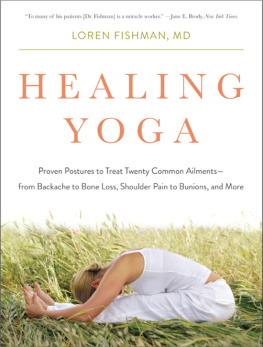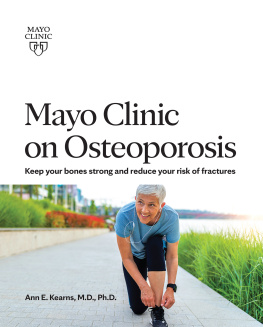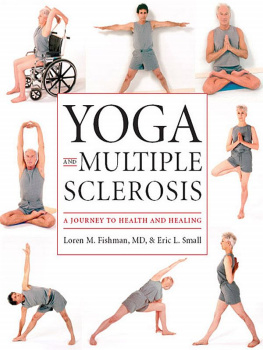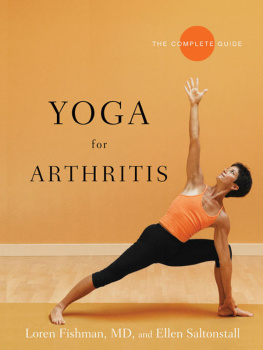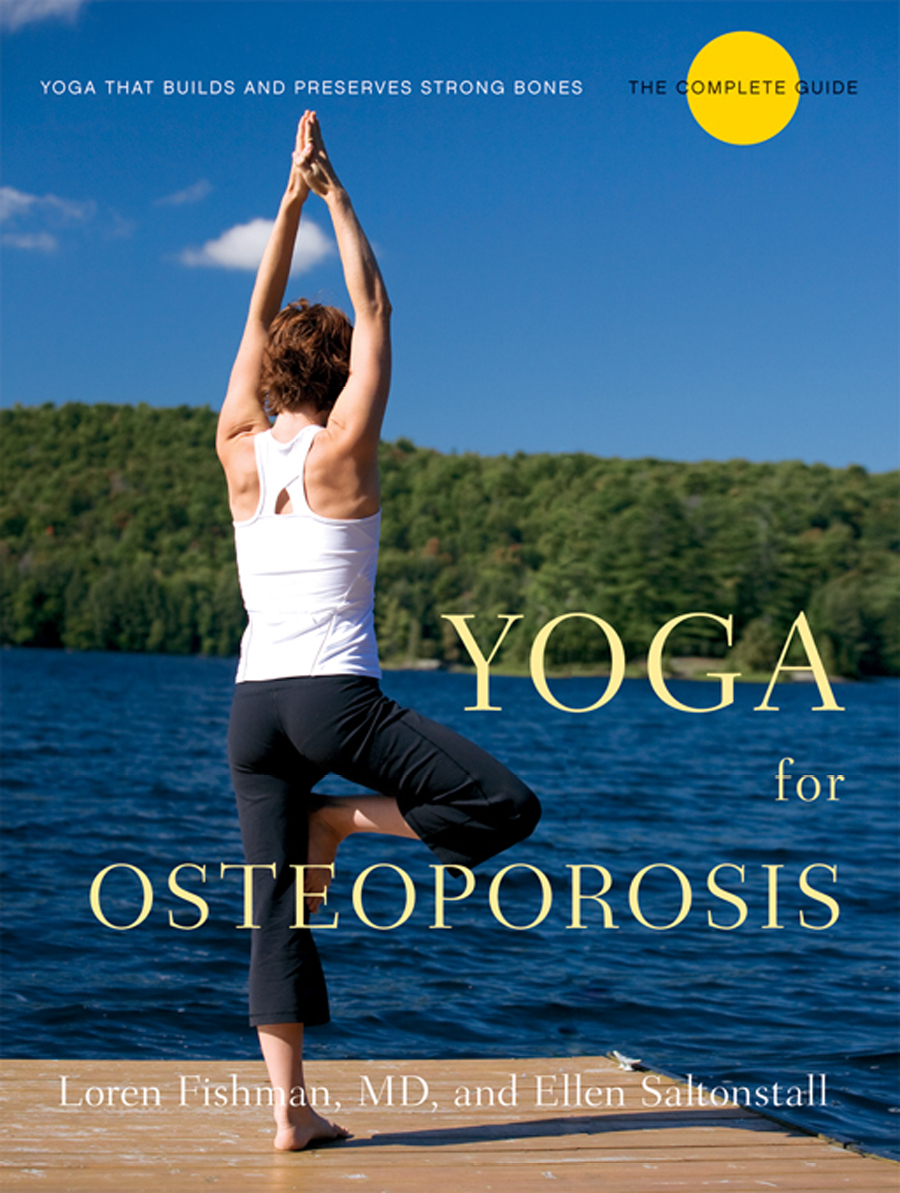
ALSO BY LOREN M. FISHMAN, MD, BPHIL (OXON.)
Back Pain: How to Relieve Low Back Pain and Sciatica
with Carol Ardman
Cure Back Pain with Yoga
with Carol Ardman
Sciatica Solutions: Diagnosis, Treatment, and
Cure of Spinal and Piriformis Problems
with Carol Ardman
Yoga and Multiple Sclerosis:
A Journey to Health and Healing
with Eric Small
ALSO BY ELLEN SALTONSTALL
Kinetic Awareness: Discovering Your Bodymind
ALSO BY LOREN M. FISHMAN AND ELLEN SALTONSTALL
Yoga for Arthritis: The Complete Guide
Yoga
for Osteoporosis
The Complete Guide
Loren Fishman, MD
Ellen Saltonstall

W. W. Norton & Company
New York London
To our teachers,
and all teachers and therapists using
HEALTHFUL means to improve health.
Contents
List of Illustrations
The wedge fracture
Normal distribution
High versus low variance
Osteoporosis and osteopenia in a normal distribution curve
DEXA scores and the risk of fracture
Normal bone
The chemical structure of hydroxyapatite
Compact and spongy bone
Eulers law and a ladder
Comparison of two types of bone structure
Bone strengthening and weakening
Osteoblasts, osteocytes and osteoclasts
How osteocytes communicate in bone
Close-up of an osteoclast
MRI of the spine of a yogi
Wollfs law and the femur
The leverage of the supraspinatus muscle
MRI: muscles and their antagonists
Spicule production: an osteoblasts response to exercise
MRI of the cervical muscles
Results of osteoporosis study
Three categories of therapy
Compression, tension, and the fate of stem cells
MRI of three different people doing Paschimottanasana
MRI showing how excessive extension affects the neck
The four corners of the foot
Manually widening the pelvis
Parallel feet
Safe and unsafe forward bends
Tadasana
Muscle action on lumbar vertebrae in back bends
MRI of Paschimottanasana
MRI of Ardha Matsyendrasana
MRI of Vasisthasana: effect on spondylolisthesis
MRI of Vasisthasana: effect on spinal stenosis
Why retrolisthesis prohibits headstand
Acknowledgments
T he authors would like to thank B. K. S. Iyengar and John Friend for their wisdom, astute precepts, and examples, and Krishnamacharya for the tradition in which so many of our teachers stand. We are extremely grateful to Tommy Moorman for his fine hand and patience in creating numerous illustrations and their numberless reincarnations in this book and in Yoga for Arthritis . We also thank Donal Holway and Julio Torres for excellent photography, Susan Genis and David Fink for remarkable guidance during the photo shoots, and Sally Hess and Rachel Fishman for their expert modeling and support. We thank our editors at W. W. NortonJill Bialosky, Evan Carver, Paul Whitlatch, Adrienne Davich, Alison Liss, and Kristin Sperberboth for making the manuscript more intelligible and for understanding us. Once again we thank Carol Stratten, Dr. David Palmieri, and Norman Brettler of Dynamic Imaging in Tilton, New Jersey, for their generous donation of time and facilities that made dynamic MRI studies of yoga possible.
Thanks to our students and patients for the many elucidating exchanges that have occurred in the process of yoga therapy; for their personal improvement they must thank themselves. Last and most overdue, we acknowledge a debt to our families for their willing sacrifices during the periods of writing and revision.
Authors Note
S cientists and healers enjoy certain rights of access: We can enter our patients personal space, ask intimate questions, and give advice that, subject to the sacred sieve of scientific skepticism, is generally taken seriously. Our rights are earned through a combination of aptitude, study, and personal trust.
But scientists and healers only exist within the complex matrix of their society, and along with their rights come certain responsibilities. Among those responsibilities are impartial seeking and sharing of the truth, articulately and intelligibly responding to problems, questioning what is seen as unwise practice or false belief, and selfless giving of help when and where it is needed. Yet national security and commercial confidentiality often require that scientists not share all information. Healers also have legally delimited confidentiality and may choose not to vitiate their gift by disseminating what is, by necessity, only part of the story. This censorship, self-imposed or otherwise, is consistent with the society-wide duty to share what one knows only if the sharing and use of the knowledge are equally discreet. Please use the information herein with humble awareness of the vast present and future human experience of which it forms a very small part.
In the healing arts a commitment to open communication must be tempered by caution. On the societal level, just as with individuals, scientists and healers have a responsibility to do no harm. Here yoga therapy leads the way. The flow and structure of what is known about yoga survives only through mutual trust, as much among those who want to know as those who know already. Being passed on from individual to individual, it nevertheless has societal aims: peace and thoughtfulness. The morality is part of the message.
There is another general problem that yoga therapy resolves rather gracefully: All the healing arts must synthesize abstract and anonymous laws of biology to accommodate individuals needs and vulnerabilities. If we just adhere to the general laws of science, individual uniqueness falls out of the equation. But if we only attend to an individuals circumstances, treatment is merely anecdotal, and the vast legacy of scientific fact is ignored. Healers are able to heal when patients trust them to adjust and apply objective laws to the advantage of the individuals particular case. This trust is what makes medical science practical and most healing possible. Yogis have been earning this trust for thousands of years.
We hope that yoga will appeal to people of all ages; we know that osteoporosis is most effectively countered in the teens and early twenties! But we expect that many people reading these words will be older, and then another consideration is relevant: the fragility of the bones, joints, and sinews. As you get beyond age 50, some experts look at the facts about mechanoreception and urge impact exercise to stave off bone loss. Unfortunately, another group of experts, with just as much empirical support, caution that impact exercise, such as jogging, can lead rather directly to osteoarthritis.
This puts older people in an impossible position: If they exercise with impact, the bones may stay strong, but the joints at either end will become painful and difficult to move. On the other hand, if they stay away from impact, they will save their joints, but the bones themselves may deteriorate. Its both ends against the middle.
We believe yoga is the answer for older people who want to stay strong, flexible, and pain-free: In yoga the joints are moved to an ever-expanding range, circulating their fluid and stimulating renewal of cartilage, tendons, and ligaments. Simultaneously, the bones are isometrically subjected to forces many times those of gravity, exactly the same forces involved in impact exercise. But in yoga, the forces are applied without any impactyoga provides an excellent solution to the twin perils of osteoarthritis and osteoporosis.
Next page

